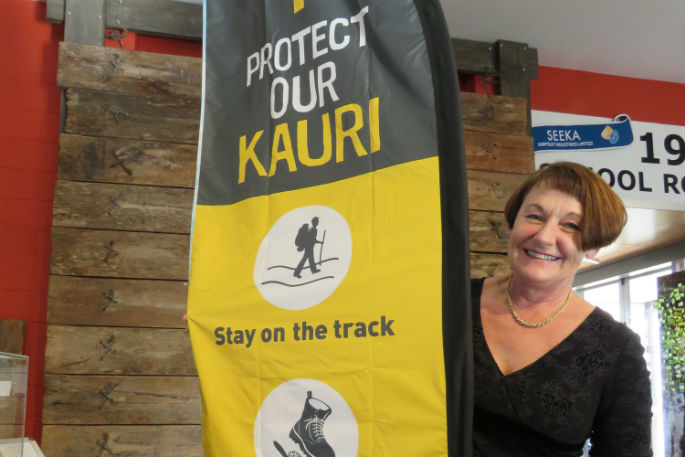A structure of wooden planks, used in the 1900s to gather and unleash water to ‘drive' kauri logs down Western Bay of Plenty hills to sawmills, is juxtaposed against the Kaimai Ranges in view at Western Bay Museum.
The salvaged section of the Wairoa Dam is a vivid reminder of how the region's early settlement milled large amounts of the native species from the range that now needs protection from a new threat – kauri dieback disease. The Kaimai Ranges is the only kauri forest free of kauri dieback.
And so her newest exhibition ‘The Kauri: The Past, The Present and the Future; is part of a joint community and DOC effort to prevent the kauri-killing disease reaching the last frontier.
'We can't change our past. We did cut kauri down here right up until the 1950s. The Cashmore and Judd Mill on Wharawhara Rd was the southernmost logging operation in New Zealand,” says Western Bay Museum manager Paula Gaelic.
'So we talk about the past in the exhibition, because kauri logging was huge here.
'But we're focused on the future – preventing kauri dieback from entering the Kaimai Ranges.”
The exhibition details six areas of the district's kauri logging past.
First, construction and use of wooden dams to ‘drive' the logs down to sawmills at lower elevations.
The unique display of some gate planks of the Wairoa Dam is courtesy of foresight of DOC ranger Warren Geraghty, who organized to have the dam's remains airlifted out of the Kaimai Ranges in the 80s.
'When this dam was in full swing, the top was as long as the museum building, 25m, and it was just under 8m high,” says Paula.
'Kauri logs were put in front of the dam, in what they called a log chute. Winter rains gathered up water behind the dam and ‘drive' the logs downstream to sawmills and then onto Diggelmann's wharf to be loaded onto the scrows.
'It would have been terrifying – imagine a wall of water as big as this building pushing logs downhill.”
There's focus on The Cashmore and Judd Mill, built in 1902 by the Bond Bros and a Mr. Judd.
Also highlighted is felling of the Lindenmann King Kauri in 1939 – a tree with a butt girth of 45ft 7in (13.7,) and a height of 75ft (22.9m) to the first branch and was bigger than today's national icon, Tane Mahuta.
Key industry figures are presented, including the Collins Brothers.
But the exhibition focuses on Tudor Collins, the younger brother of Bert and Reg, who were running the Coromandel's kauri logging industry before arriving in Katikati.
The exhibition is open to the public – and to school-aged children via the museum's education programmes.
The newly-launched Lions Club of Katikati – Museum Learning Experience has been perfect timing, with already 240 local students visiting.
Nearby at The Arts Junction a new kauri mural ‘Te Wao Tauanui a Tane' (The sacred domain of Tabe), is another visual reminder to all about the precious state of the nearby forest.
Paula says kauri logging was wasteful without a doubt.
'But at the time they really thought what they were doing was developing the district, as many other bushmen around New Zealand thought too.
'We cannot change history but we can certainly make every possible attempt to save our majestic kauri.
'We all need to read the DOC signs, wash our boots on our way in and out, stay on the tracks and stay away from those closed.”
The exhibition closes November 30.
See: www.nzmuseum.nz



0 comments
Leave a Comment
You must be logged in to make a comment.